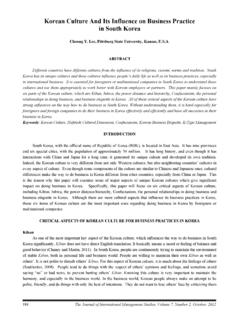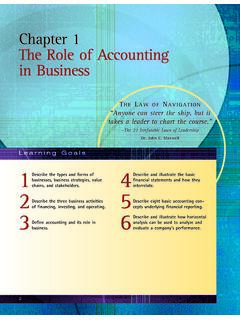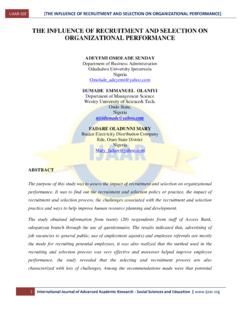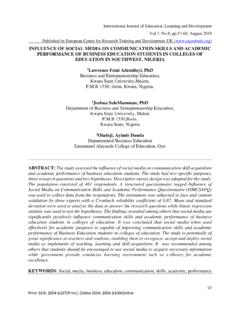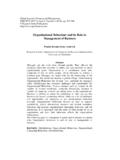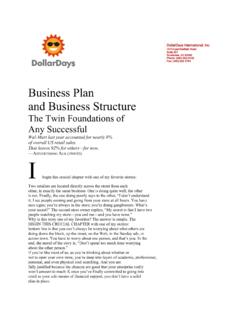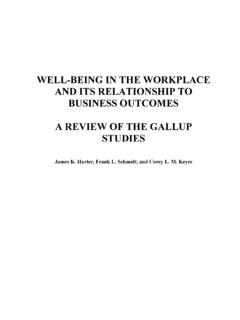Transcription of The Next Generation of IT Operating Models 6 Key Themes ...
1 The Next Generation of IT Operating Models6 Key Themes for CIO sHow is the traditional enterprise IT Operating model evolving? 1IT is the business 2E2E: business -outcome focussed IT 4 Speed: Delivering better IT faster 6 The commercialisation of IT 8 Intelligent integration 10 Vendor collaboration 126 key Themes looking at how the impact of new technology drivers are changing IT Operating start a new section, hold down the apple+shift keys and click to release this object and type the section title in the box more inter-connected world is driving changes in the way that technology is used within businesses and by individual consumers.
2 The ability of customers and employees to access services through an array of channels, stay in touch around the globe and consume & share information, any time, anywhere is becoming near , green-field IT is a rare thing these days. CIO s now have to build continually on foundations and plans that were established by their predecessors over the last few decades when enterprise technology, communications and channels to market were very organisations need to evolve and ensure their Operating Models are meeting the many and varied challenges of the new technologies in the interconnected , many enterprise IT organisations have developed in response to four key drivers:Simple & Reliable Service DeliveryStandardisationLower Cost BaseCentralisation and ControlHow is the traditional enterprise IT Operating model evolving?Our experience is now showing that in the past 12 24 months there has a been a rapid evolution of these traditionally inward-facing drivers for IT.
3 This is resulting in a brand new set of challenges that CIO s must address. These drivers can be summarised as:DriverDescriptionSpeed of DeliveryDelivering better, more innovative and intuitive technology and services faster and cheaper than ever beforeFocus on business OutcomesDelivery of end-to-end, outcome based services driven and enabled by IT focussing on creating, building and maintaining business valueHigher business dependency on ITDigitisation of business processes, Big Data and business Intelligence driving predictive analytics and blurring any distinction between IT and the businessDisruptive New TechnologiesResponding to new, on-demand, SaaS, and IaaS offerings, cyber security requirements, leveraging the Internet of Things as well as integrating social and mobile technologiesNew, disruptive technologies are impacting the people, processes and governance in IT contactsStephen MercerTechnology Partner+44 (0)7836 EversonPartner, Head of IT Transformation+44 (0) 7901 CoxIT Strategy & Operating Model Lead+44 (0)
4 7768 Next Generation of IT Operating Models 6 Key Themes for CIO s 1To start a new section, hold down the apple+shift keys and click to release this object and type the section title in the box is the businessBack-office no longer ..What is the trend?As businesses evolve, information and technology will increasingly underpin every aspect of the new business Models . CIO s need to grow and evolve their IT departments enabling the digitisation of business processes and delivering products and services to business users and customers that drive the creation of business value. IT cannot do this stuck in a back-office. Expectations on IT have never been higherHeightened user expectations are requiring greater IT reach. With the creation of new customer touchpoints and channels to market, an increasing demand for digital content and a shift towards thin client terminals and tablet based apps, businesses must adapt to keep up with the pace of innovation. Ever-inflating customer expectations are pushing businesses to respond, leveraging their IT capabilities to get closer to their customers and pulling multiple data sources together intelligently to deliver more value, both to the customer and the business .
5 Customer-facing IT services must meet the quality, speed and versatility expected of increasingly underpins all aspects of the business from the back-office, through operations, and into commercial and customer-facing functions. IT plays a fundamental role in a business ability to deliver products and services that meet or exceed customer (and data) is powerCompanies are recognising the power of analytics, using it to provide real-time insights to inform new imperatives and business decisions. While management has traditionally had access to real-time data, weaving analytics into workspaces from the shop-floor to back-office functions enables employees to set goals, identify problems and be proactive in identifying new opportunities and risks. For analytics to become a powerful tool in creating a proactive company culture, the organisation must have full-system visibility and access to real-time, trustworthy data. Embedded analytics will enable employees to monitor issues continually, predict customer needs and make well informed you ve never failed, you ve never livedNew digital technologies are changing the way that people within IT organisations must work.
6 For analytics to deliver actionable insight and for multi-channel offerings to deliver real value, a culture of innovation must be encouraged. IT leaders must encourage their staff to spend time on innovative projects. These behaviours must first be embedded and then expected. There must be a level of tolerance for creative failure to encourage risk taking in an environment where fallout and impact is contained. IT as a Venture CapitalistIT organisations must embrace the challenge to trade on its assets, talent, risk and results. IT organisations that are keen to help drive business growth and innovation must develop a new mind-set alongside new capabilities. IT should encourage intelligent risk-taking; failure due to poor execution is unacceptable, however setbacks arising from exploring and testing innovative ideas are inevitable for those that want to compete and thrive in a high-growth environment. The portfolio mindset of a VC needs to be adopted; balancing investments in legacy systems and innovation, communicating portfolio performance in terms of business value, and aligning talent with the business start a new section, hold down the apple+shift keys and click to release this object and type the section title in the box is this important?
7 The pace of technological change and the rise of multi-channel is increasing business reliance on IT and technology Increasing number of consumer touchpoints requires IT to respond to demands and provide seamless integration across business channels through operations and into corporate IT and processes Utilising analytics and real-time data, IT departments can proactively monitor and predict future customer trends allowing for differentiation and improved customer and user experience Leverage the creative power of IT staff by embedding a culture of innovation: gamification can also help IT to deliver what the business needsHow should IT respond?New or Impacted Roles Touchpoint Specialists build a detailed knowledge of specific customer touchpoints in order to understand the key influences on the customer experience Head of Innovation overall accountability for encouraging and enabling innovation within the IT department and more widely into the businessProcess Digitisation of processes means that IT will underpin and enable more and more of the core business processes Performance management processes should encourage and incentivise staff to spend time pursuing innovative solutions and IT leaders should encourage and reward progressive failure Innovation Portfolio Management processes should exist to provide the necessary access to finance required to fund innovation and the time people spend developing ideasTechnology Development of Integration layers to enable services to be delivered across multiple channels (and their associated touchpoints)
8 To avoid creating information siloes Invest in technologies that allow data to be interrogated so that analytics will provide actionable insight Sand-pit capabilities need to be established where innovative solutions can be tried and testedIn the future, information and technology will underpin and enable every aspect of the business Operating Next Generation of IT Operating Models 6 Key Themes for CIO s 3To start a new section, hold down the apple+shift keys and click to release this object and type the section title in the box : business -outcome focussed ITDefining everything we do by the value deliveredIT plays a critical part in delivering business outcomes. When these outcomes are not delivered any excuses from IT around technology-based SLAs being met will no longer be acceptable. IT needs to understand the part it plays in creating business and shareholder value, and in driving company is the trend?IT is not a back-office ivory tower, nor should it be divorced from the business , Operating with a them and us mentality.
9 Instead IT and the business need to work together, contributing to the creation of business value. In some instances, as discussed elsewhere, IT is the business expects: IT must deliverBusinesses depend on IT to make money and this dependency is increasing with the digitisation and automation of business processes. IT must think of everything it does in terms of End-to-End delivery across the business value chain. IT can no longer be oblivious to what happens when points of failure occur in the value chainBusiness outcomes are dependent on IT outcomes and are enabled by the managed integration of IT services. As such, when a business outcome is not met it is extremely likely that a piece of technology or infrastructure that sits behind it is at least partially to blame; an application crashed, a server went offline or there was a network outage of some with Enterprise IT s performance is therefore based on the enablement and improvement of business outcomes rather than achieving traditional technical tower-based SLAs and IT does not understand the End-to-End value contribution of individual IT components of the service, there is potential for a disconnect to be created between what matters to the business and what matters to IT leaders and CIO s.
10 For example, it is possible for IT to achieve all of its technical tower-based SLAs and targets, but remain oblivious to the fact that something has fallen over in the wider business value chain ( product not having been shipped or reports not having been generated).Understanding what failure to deliver means to the end userEnd-to-End Operating Models see tower-provided services replaced with complete End-to-End service stacks that are integrated across technologies and articulated in terms of End-to-End business processes. Dedicated service owners are responsible for each service and are able to influence the delivery of all tower IT components that form this service. The service owner would understand the impact of failure for each is not to say that there should be a wholesale shift to an End-to-End model, rather that it is an appropriate model to adopt when delivering a defined and manageable number of critical business start a new section, hold down the apple+shift keys and click to release this object and type the section title in the box is this important?










